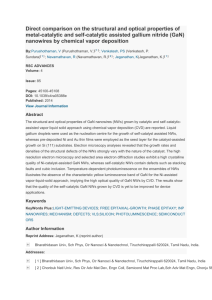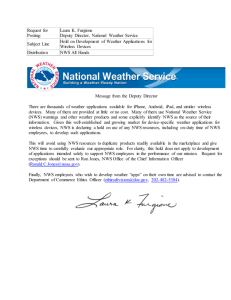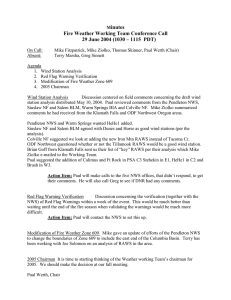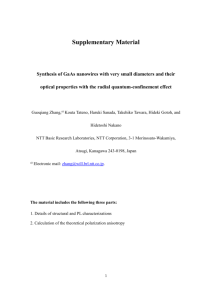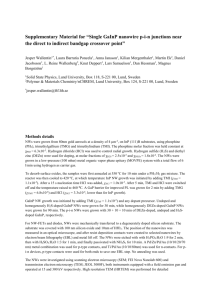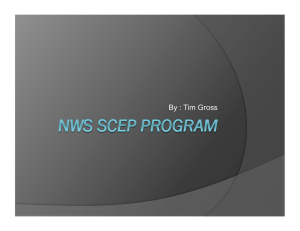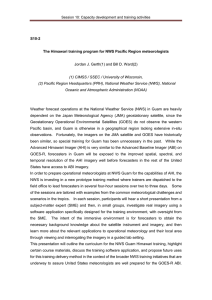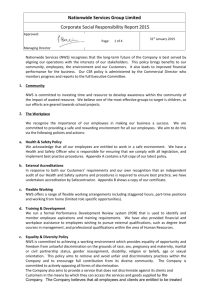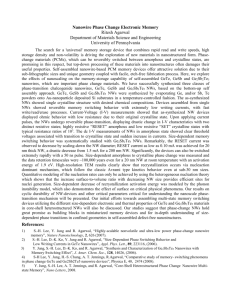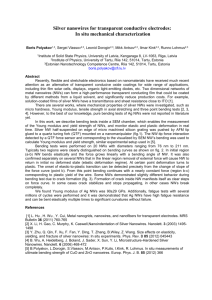Supporting Information
advertisement
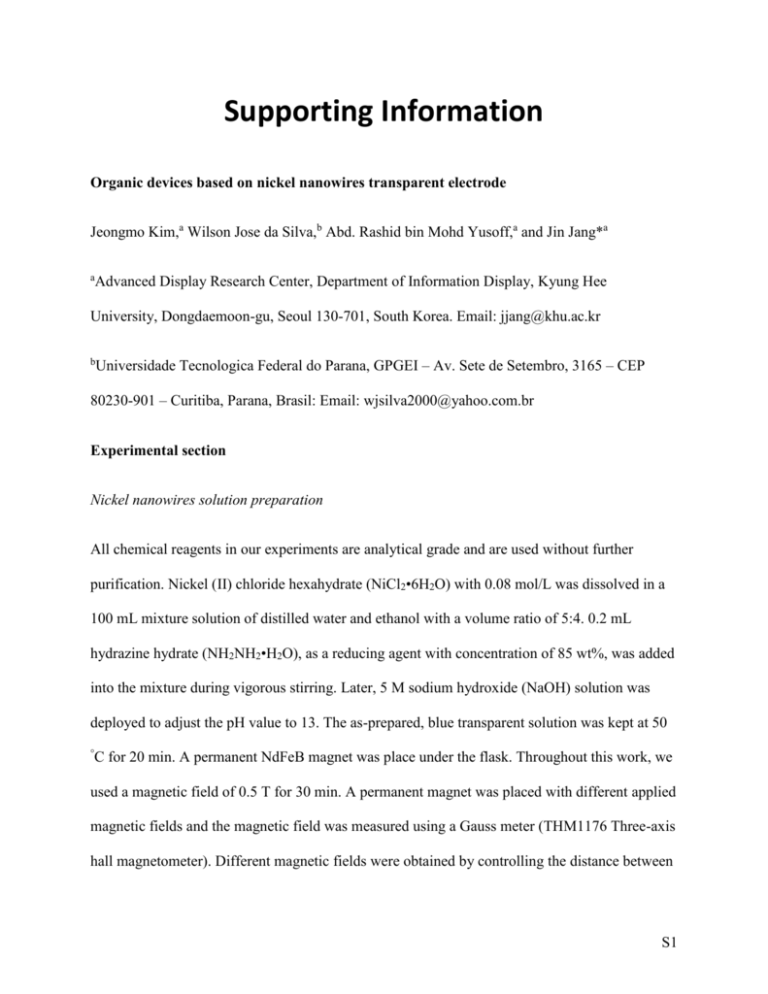
Supporting Information
Organic devices based on nickel nanowires transparent electrode
Jeongmo Kim,a Wilson Jose da Silva,b Abd. Rashid bin Mohd Yusoff,a and Jin Jang*a
a
Advanced Display Research Center, Department of Information Display, Kyung Hee
University, Dongdaemoon-gu, Seoul 130-701, South Korea. Email: jjang@khu.ac.kr
b
Universidade Tecnologica Federal do Parana, GPGEI – Av. Sete de Setembro, 3165 – CEP
80230-901 – Curitiba, Parana, Brasil: Email: wjsilva2000@yahoo.com.br
Experimental section
Nickel nanowires solution preparation
All chemical reagents in our experiments are analytical grade and are used without further
purification. Nickel (II) chloride hexahydrate (NiCl2•6H2O) with 0.08 mol/L was dissolved in a
100 mL mixture solution of distilled water and ethanol with a volume ratio of 5:4. 0.2 mL
hydrazine hydrate (NH2NH2•H2O), as a reducing agent with concentration of 85 wt%, was added
into the mixture during vigorous stirring. Later, 5 M sodium hydroxide (NaOH) solution was
deployed to adjust the pH value to 13. The as-prepared, blue transparent solution was kept at 50
°
C for 20 min. A permanent NdFeB magnet was place under the flask. Throughout this work, we
used a magnetic field of 0.5 T for 30 min. A permanent magnet was placed with different applied
magnetic fields and the magnetic field was measured using a Gauss meter (THM1176 Three-axis
hall magnetometer). Different magnetic fields were obtained by controlling the distance between
S1
the flask and the magnet. Finally, the grey-black fluffy solid product floated to top of the solution
surface and the solution became colorless and transparent. The product was collected and washed
several times using distilled water and ethanol under an applied magnetic field and then dried in
a vacuum oven at 60 °C for 12 h.
Silver nanowires
Ag NWs was obtained from Blue Nano Inc. with an average diameter of 90 nm and length of 1030 m. The obtained concentration was 10 mg/mL which was diluted to desired concentrations
prior casting as films.
Characterizations
Powder X-ray diffraction (XRD) patterns were recorded using a Bruker diffractometer with Cu
Kα radiation (D8 Advance X-ray diffractometer, Cu Kα, λ = 1.5406 Å, 40 kV, and 40 mA) to
study the crystallographic information of the samples. Field-emission scanning electron
microscopy (FESEM; JEOL, JSM-6700F, 5 kV) equipped with energy-dispersive X-ray
spectroscopy (EDX) was used to analyze the morphology and elemental composition of the
samples. The surface properties of the samples were analyzed with an X-ray photoelectron
spectroscopy (XPS; VG ESCALAB MKII instrument) that uses a Mg Kα X-ray source. The
survey scans were collected using a pass energy of 160 eV. High-resolution spectra of the
individual elements were collected with the analyzer pass energy set at 40 eV. The pressure of
the analyzer chamber was maintained at 10−9 Pa during the measurement. Before the analysis, all
the samples were dried under a vacuum at 80 °C overnight. Raman scattering experiments were
performed at room temperature using a Ramanor T-64000 microscopy system (Jobin Yvon,
Longjumean, France). Contact angle measurement was performed using an Attension Theta
S2
optical tensiometer with automated liquid pumping system was used for the contact angle
measurements. Purified (Milli-Q) and degassed water was used as the probe liquid.
Fabrication of OLED
OLEDs were fabricated on Ni NWs-coated glass substrates with a sheet resistance of 19 Ω/sq.
Before device fabrication, the glass substrates were cleaned with Decon 90, rinsed in de-ionized
water, dried in an oven at 120°C, treated with UV-ozone, and transferred to a vacuum deposition
system with a base pressure better than 1×10−6 mbar for organic and metal deposition. The
devices were fabricated by evaporating organic material onto the PEDOT layer sequentially with
an evaporation rate of 1–2 Å/s .The cathode was completed through a thermal deposition of LiF
at a deposition rate of 0.1 Å/s, and then capped with an Al metal through thermal evaporation at
a rate of 10 Å/s. The current−voltage−luminance characteristics were measured using a Keithley
236 source measurement unit and a Minolta CS2000 Spectroradiometer.
Fabrication of OSC
OSCs were developed on Ni NWs-coated glass substrate with a sheet resistance of 19 Ω/sq.
Before device fabrication, the glass substrates were cleaned with Decon 90 and rinsed in deionized water. Then a 30 nm thick PEDOT:PSS (Argos Organic Chemicals) hole conducting
layer was spin-casted onto the Ni NWs electrode (4000 rpm, 1 min). The samples were then
baked at 115 °C for 15 min on a hot plate. A bulk heterojunction (BHJ) layer was spin-casted
onto the PEDOT:PSS layer. The solution was prepared by dissolving poly({4,8-bis[(2ethylhexyl)oxy]benzo [1,2-b:4,5-b’]dithiophene-2,6-diyl}{3-fluoro-2-[(2ethylhexyl)carbonyl]thieno[3,4-b]thiophenediyl}) (PTB7-Th) and [6,6]-phenyl C71 butyric acid
methyl ester (PC71BM) in a 1:1.5 weight ratio in a 3% diiodooctane-containing chlorobenzene
S3
solvent. A 6 nm thick ZnO layer was coated onto the BHJ layer. Finally, a 100 nm thick Al
cathode was thermally evaporated under 10−7 Torr. The J−V performances of the OSCs were
measured using an Oriel 91193 (1 kW lamp, 100 mW/cm2) device, an NREL-calibrated Si solar
cell, and Keithley 2400 source meters. An aperture was used to determine the cell area. The
incident photon-to-current efficiency (IPCE) measurements were conducted using a Solar Cell
QE/IPCE (Zolix Solar Cell Scan 100).
(a)
16
Count
12
8
4
0
60
80
100
120
Diameter (nm)
140
(b)
S4
21
18
Count
15
12
9
*
6
3
0
30 40 50 60 70 80 90 100
Length (nm)
Figure S1. Diameter (a) and length (b) distributions determined from 72 Ni NWs. A relatively
Transmittance (%)
high number in (b) * probably comes from nanowire breaks during the purification step.
100
90
80
0.00
0.05
0.10 0.15 0.20
Ni Nws (g.m-2)
0.25
Figure S2. Transmittance vs. Ni NWs network density.
S5
Figure S3. AFM images of the Ag NWs (upper panel) and Ni NWs (down panel).
S6

